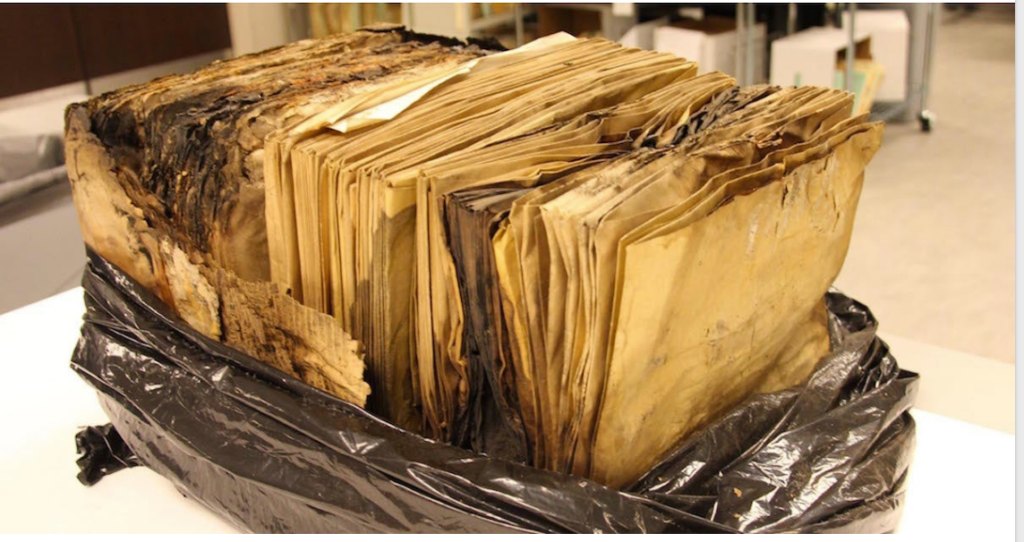4. FIRE PROTECTION

SAA’s fourth category of focus concerns the application fire safety measures to prevent archives from destruction.
Considerations and Rationale:
Archive collections are one of a kind and cannot be replicated. As a result, archive facilities require a higher level of fire safety than is normally required for commercial buildings (SAA, 2009, p.45). The SAA, therefore, reasoned that guidelines and fire safety objectives were necessary. The fire protection guidelines provided by the SAA was established for the purposes of complimenting previously established fire codes (SAA, 2009, p.45).
GUIDELINES:
- Every facility must have an established fire safety objective and must establish acceptable loss levels and subsequent protection levels for archival collections, the building, and the continuity of operations (SAA, 2009, p.45).
- Life safety must not be less than prescribed by mandated local, state, provincial or federal codes and standards (SAA, 2009, p.45).
- The fire detection and alarm system must include Americans with Disabilities Act (ADA) features and functionality (SAA, 2009, p.45).
- Archives must be provided with a reasonable level of protection against damage or loss from fire, combustion products and fire suppression actions (SAA, 2009, p.46).
- The archives facility must be designated a smoke free building (SAA, 2009, p.46).
- The archives program must be reasonably protected against operational downtime and impact from fire, combustion products and fire suppression actions (SAA, 2009, p.46).
- A fire risk assessment must be conducted when planning a new facility or major renovation to an existing facility (SAA, 2009, p.46). This assessment must identify potential fire threats and their potential impact on the facility, collections, organizational mission and persons within the structure (SAA, 2009, p.46).
- Construction requirements for the repository must comply with the National Fire Protection Association (NFPA) #232 (standard for the protection of Records and Storage) and #909 (Code for the Protection of Cultural Resources) and the local mandated building code (SAA, 2009, pp. 46-47).
- Archival stacks and facilities that consist of archival stacks must be constructed to resist the entry of fire, smoke, water, and toxic gases (SAA, 2009, p.47).
- Walls, ceiling, and floors of a stack must be constructed of Masonry (SAA, 2009, p.47).
- Combustible materials should not be used in any portion of the stack’s construction, finishes, or any portion of the building’s structural members that support the stack (SAA, 2009, p.47). Additionally, these structures should be designed to withstand all the conditions that a fire may impose upon it for the entire fire duration (SAA, 2009, p.48). In addition, the structure should have a fire resistance rating at least equal to that of the stack enclosure (SAA, 2009, p.48).
- All stack door openings must be protected with fire rated doors with a fire rating in hours equal to the classification of the stack walls (SAA, 2009, p.49). Doors must be listed and labeled in accordance with American National Standards Institute (ANSI)/Underwriters Laboratories (UL) 155, Tests for Fire Resistance of Value and File Room Doors (SAA, 2009, p.49). Stack doors must be equipped with automatic losing devices to maintain the door in a normally closed an latched position (p. 49). All other fire doors in the repository must be equipped with automatic closing devices and maintained in a normally closed position (SAA, 2009, p.49).
- Elevators, stairways, conveyors and other shafts should not open directly to the archival stacks (SAA, 2009, p.49).
- Portable heating, air conditioning, or humidity control equipment must not be used in archival stacks (SAA, 2009, p.49).
- Boilers, furnaces, humidification, dehumidification, air conditioning and other climate conditioning equipment that serve the stack must not be located within the archival stack enclosure(SAA, 2009, p.49).
- Once a fire starts, it must be detected an an alarm sounded (SAA, 2009, p. 51). All archival facilities must have automatic fire detection and alarm systems(SAA, 2009, p. 51). The smoke detection/fire alarm system shall be connected to an approved central fire station monitoring device (SAA, 2009, p. 51).
- Repositories must be provided with automatic smoke detection (SAA, 2009, p. 51). Areas in which smoke detection are not feasible (i.e. subject to freezing), should be provided with rate-of-rise thermal detection or other suitable thermal detection (SAA, 2009, p. 51).
- Once the fire has been detected it must be extinguished to limit damage to archival collection and the facility (SAA, 2009, p.52). If the fire is detected while it is small and a trained person is present, it can be controlled with a portable fire extinguisher or other similar manual fire fighting tool (SAA, 2009, p.52). If, however, the fire exceeds approximately 3 feet in height, professional fire fighters are required to extinguish the fire (SAA, 2009, p.52). Automatic fire suppression systems may assist in identifying a developing fire and respond within minutes to isolate the fire’s size until the fire department arrives (SAA, 2009, p. 52).
- Fire Suppression systems must be designed and installed in accordance with applicable National Fire Protection Association (NFPA) standards (SAA, 2009, p.53).
- Automatic Suppression systems must be provided for stacks greater than 500 square feet (46.5 square meters) in area (SAA, 2009, p.53). Automatic fire suppression systems must be provided for all stacks where compact mobile shelving is used for the storage of collections (SAA, 2009, p.54). All areas where archival materials are exhibited, treated or temporarily stored must also consist of an automatic fire suppression system (SAA, 2009, p.55).
- Clean agent fire suppression systems or pre-action sprinkler systems must be used in cold stacks and other areas subject to temperatures below forty degrees Fahrenheit (SAA, 2009, p.55).
- All floor areas must be provided with portable fire extinguishers that are appropriate for the anticipated fire scenario (SAA, 2009, p. 52). Fire extinguishers shall be installed in accordance with the current pamphlet of NFPA #10, Standard for Portable Fire Extinguishers(SAA, 2009, p.52).

